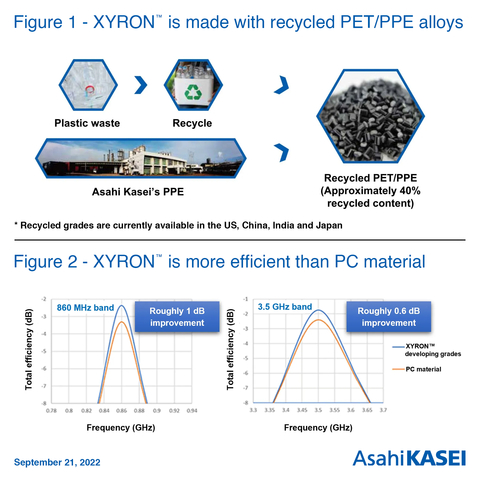Asahi Kasei Introduces New XYRON™ mPPE Grades – Versatile Materials for Improved Efficiency of 5G Applications
Asahi Kasei is launching new grades of XYRON™ modified polyphenylene ether (mPPE) to enhance 5G applications in North America and Europe. These materials offer improved connectivity, lighter weight, and higher heat resistance than traditional metals. Key features include low dielectric permittivity and high hydrolysis resistance, resulting in better efficiency for 5G smartphone antennas and base stations. The new recycled PET/PPE alloys utilize 40% post-consumer materials, supporting sustainability. XYRON™ will be showcased at K 2022 in Düsseldorf from October 19-26.
- Introduction of XYRON™ grades will enhance efficiency and connectivity of 5G networks.
- XYRON™ materials are lighter and offer higher heat resistance compared to conventional materials.
- XYRON™ supports sustainable manufacturing with 40% post-consumer recycled content.
- None.
Insights
Analyzing...
-
Asahi Kasei is introducing new grades of XYRON™ that can improve connectivity of 5G networks toNorth America andEurope - XYRON™ grades for RF filters are lighter weight and offer higher heat resistance than metallic materials
- XYRON™ allows for a more sustainable manufacturing process with fewer design constraints
-
XYRON™ will be featured at K 2022 in Düsseldorf
Germany (Hall 8a, Booth E23).

The recycled PET/PPE alloys use approximately
5G networks are expected to offer maximum data transmission speeds about 10 times greater than those of 4G networks. Compared to their predecessors, 5G networks also use higher-frequency electromagnetic signals than previous network generations. However, this comes at a cost. As signal speeds increase, the strength of the signal becomes exponentially weaker, so high-frequency signals like 5G suffer much greater loss than lower-frequency signals like 4G, thus have greater difficulty in reaching their intended destinations. This poses challenges for network connectivity and can serve as an obstacle to ensuring reliable communication. For this reason, 5G networks require more base stations than previous generations, and 5G smartphone terminals must incorporate higher-performance radio systems to ensure reliability and satisfaction.
MID antennas for 5G-compliant smartphones
XYRON™ grades for MID (molded interconnected device) antennas feature low dielectric permittivity, low loss tangent and high hydrolysis resistance. Simulation results indicate that the use of these materials in MID antennas can improve total efficiency by as much as 1 dB compared to the polycarbonate (PC) materials conventionally used for this purpose. This enables operation at higher frequencies and more advanced device functionality, alleviating design space constraints to facilitate.
Antenna covers for 5G base stations
Antenna covers – the outermost layers of antenna assemblies – require lightweight, weather-resistant materials with low dielectric permittivity to improve electromagnetic-wave transmissivity. To date, antenna covers have typically been made from PC or similar materials, which hinders dielectric properties.
RF cavity filters for 5G base stations
Base stations commonly incorporate large numbers of metal or ceramic radio frequency (RF) filters that increase system weight, leading to a more complicated installation and operating losses. The greater density of base stations required for 5G networks makes these factors even more important and creates an urgent demand for lighter-weight components.
XYRON™ grades for RF filters – specifically designed for applications to RF cavity filters in 5G base stations – offer high heat resistance, good plating properties, and low linear-expansion coefficients comparable to those of metallic materials, facilitating the industry’s transition to resin-based RF filters.
Recycled PET/PPE alloys for 5G smartphone terminal chassis
Remaining committed to developing innovative materials for sustainable societies,
The recycled PET/PPE alloys use approximately
Learn more about Xyron’s 5G capabilities.
About
Asahi Kasei is also dedicated to sustainability initiatives and is contributing to reaching a
View source version on businesswire.com: https://www.businesswire.com/news/home/20220921005167/en/
Company Contact
E-mail: AKA-info@ak-america.com
Company Contact Europe:
Fringsstrasse 17, 40221 Düsseldorf
Tel: +49 (0) 211-3399-2058
E-mail: sebastian.schmidt@asahi-kasei.eu
Source: Asahi Kasei







